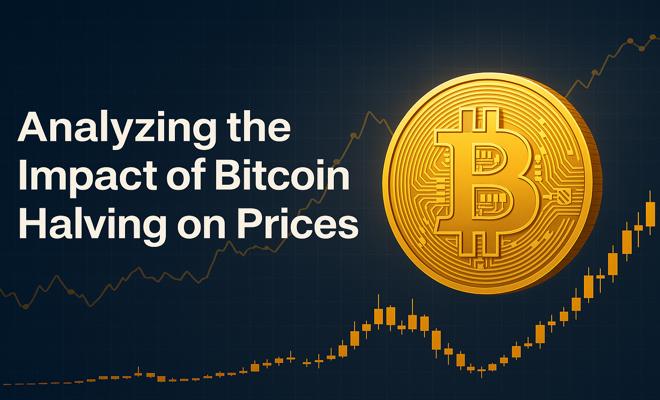
🔍 Analyzing the Impact of Bitcoin Halving on Prices
If you're curious about Bitcoin or just getting started with cryptocurrencies, you've probably heard the term Bitcoin halving floating around. But what exactly is halving, and why does it matter? In this article, we'll break down the concept in simple terms, walk through its history, analyze its effects on Bitcoin's price, and explore what the future might hold. Let’s dive in!
🌟 What Is Bitcoin Halving?
Bitcoin is a digital currency with a fixed supply — only 21 million bitcoins will ever exist. To keep Bitcoin scarce and prevent inflation, its protocol includes an event called halving, which happens roughly every four years.
During a halving, the reward miners receive for verifying transactions and adding new blocks to the blockchain is cut in half. For example, if miners were earning 6.25 bitcoins per block, after a halving, they receive just 3.125 bitcoins.
🌱 This process slows down the rate at which new bitcoins are introduced into circulation, making Bitcoin progressively scarcer over time.
📅 A Look Back: History of Halvings and Price Movements
So far, there have been four Bitcoin halvings, each with notable effects on Bitcoin's price. Here’s a quick recap:
1. First Halving — November 2012
- Mining reward dropped from 50 BTC to 25 BTC per block.
- Price at halving: around $12
- About a year later, price surged to nearly $1,000!
2. Second Halving — July 2016
- Reward cut from 25 BTC to 12.5 BTC.
- Price at halving: roughly $650
- Within a year, price skyrocketed to almost $20,000.
3. Third Halving — May 2020
- Reward dropped from 12.5 BTC to 6.25 BTC.
- Price at halving: about $8,500
- Over the next 12 months, price climbed above $60,000.
4. Fourth Halving — April 2024
- Reward cut to 3.125 BTC.
- Price at halving: near $64,000
- As of mid-2025, price ranges between $90,000 and $110,000.
💡 Important: While halvings have historically been followed by significant price increases, these rises are often gradual and accompanied by market volatility.
📈 Why Does Halving Affect Bitcoin’s Price?
From an economic perspective, when supply decreases but demand stays the same or grows, prices tend to rise. This is a simple rule of supply and demand, and Bitcoin is no exception.
Halving cuts the flow of new bitcoins entering the market in half, creating scarcity. As more people want to buy Bitcoin while fewer new coins are available, prices naturally increase.
📊 The popular Stock-to-Flow model compares the existing stock of Bitcoin to the new supply added each year, suggesting that the scarcer Bitcoin becomes, the higher its value.
🧠 Market Psychology and Investor Behavior
Halving is not just a technical event; it also influences how investors feel and behave. Anticipation around halving tends to create positive sentiment and buying momentum.
- Fear of missing out (FOMO) drives many to buy.
- Media coverage and expert analysis bring more attention to Bitcoin.
- Sometimes, traders sell quickly after halving to lock in profits, causing price swings.
📉 Does Halving Always Mean Price Growth?
Not necessarily. The cryptocurrency market is complex, influenced by many factors, including:
- Global economic conditions and interest rates
- Government regulations and policies around cryptocurrencies
- Technological developments and adoption rates
Also, as Bitcoin’s market matures, some believe the impact of halving events may gradually lessen since these are anticipated and priced in ahead of time.
🔮 What’s Next? The Future After the 2024 Halving
Based on current trends and historical data, Bitcoin’s price is expected to continue its upward trajectory over the next 12 to 18 months, though volatility and corrections are likely.
The next halving is forecasted around 2028, cutting the mining reward to 1.5625 BTC. With fewer new bitcoins entering circulation, scarcity will increase further — potentially pushing prices even higher, depending on market conditions.
💡 Key Takeaways
Bitcoin halving is a crucial mechanism designed to reduce supply gradually, making Bitcoin more scarce and potentially more valuable over time.
While past halvings have preceded significant price increases, many factors influence Bitcoin’s market, so caution and informed decision-making are essential.
Summary:
- Halving happens roughly every 4 years, halving miner rewards.
- Historically, halvings have led to price increases, though with ups and downs.
- Economic, regulatory, and psychological factors all play roles.
- Future halvings will continue shaping Bitcoin’s supply and potentially its value.
If you have any questions about Bitcoin halving or cryptocurrency in general, feel free to ask! And don’t forget to check BitMedia24 for the latest crypto news and in-depth analysis.